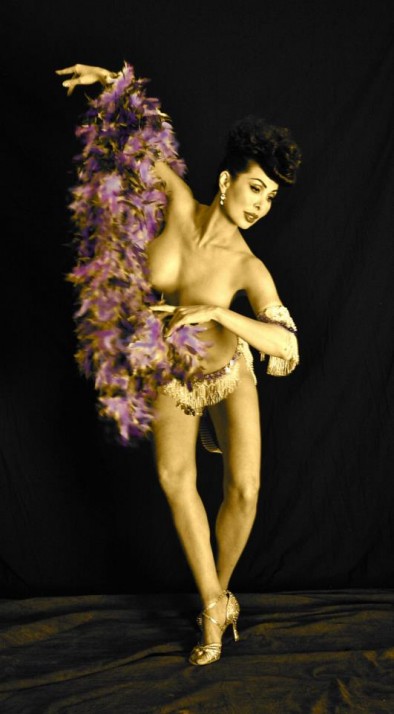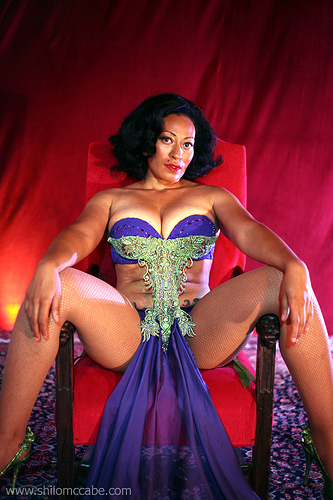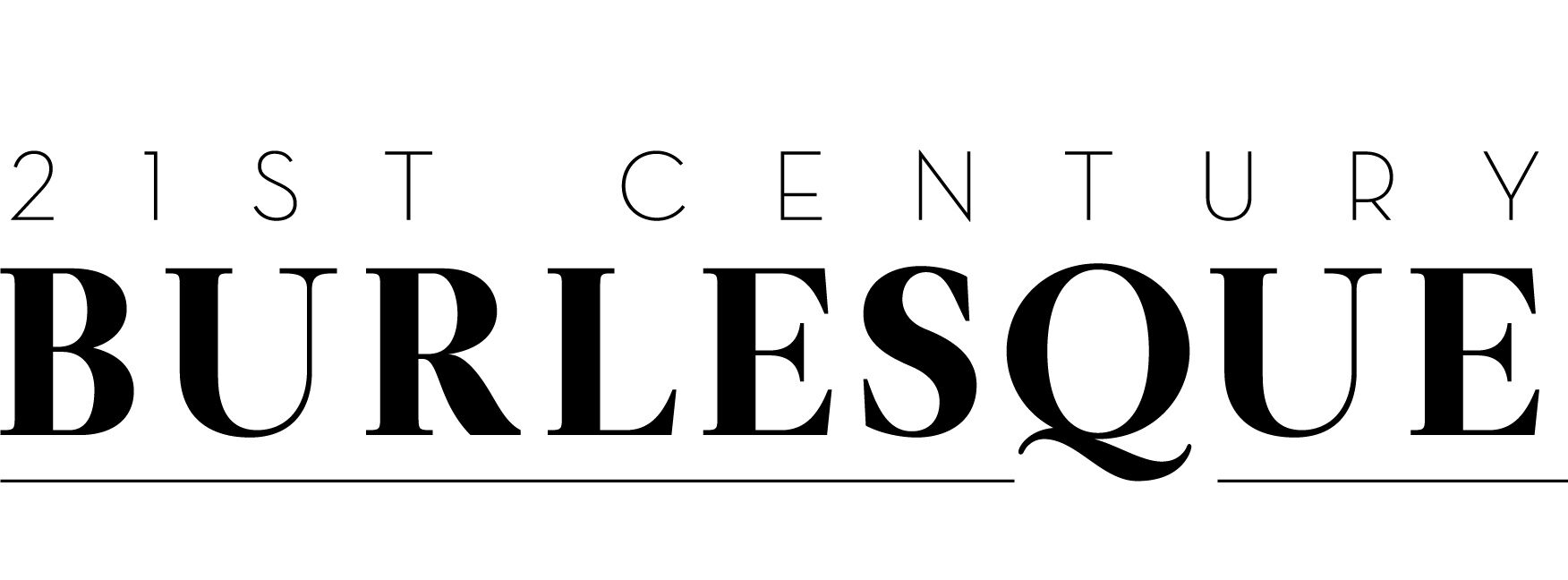Here is Part Two of the full Race and Burlesque: The Curious Case of the Performer of Colour interviews. Conducted by Chocolat the Extraordinaire. (Click on the performer names to visit their websites.)
Sydni Deveraux
What drew you to burlesque? Why did you start performing?
I found burlesque in 2005. I was already a jazz singer, and through pin-up modelling and my love of cheesecake vintage pin-ups I found the website SuicideGirls. I became a model with them and was participating in regional group activities. From there I found out that there was a burlesque show in Seattle. I went, and I fell in love with the idea that I could be glamorously dancing to the songs that I loved singing, to the genre that inspires me. I suppose I was always a ‘secret dancer’; I would dance/strip in my room growing up, mimic dance routines, in high school I was a cheerleader… I think it was a natural progression. Fancy ladies in magnificent dresses and exquisite pieces of music have always drawn my attention.

Were you aware that you would be one of very few performers of colour when you started?
To be honest, it never occurred to me. I just wanted to do something that spoke to me. I’ve never let the participation or lack of participation by anyone else effect my decisions. Over time I certainly could ‘see’ it, but it’s never stopped me from participating in burlesque, since burlesque is a part of me. I love seeing the visibility grow, and the puzzle pieces of history fill in the blanks, but it’s slow going.
What do you think the reason is for this?
Visibility and history sources. The sexualisation of African-Americans throughout history. For instance, I once performed for an entirely black audience and it became clear to me that I was exactly what the entire culture had been fighting against for so long – the hyper-sexualisation of its women. Unlike other audiences, it was like pulling teeth to get anyone to ‘play’ with me: avoiding eye-contact, no hooting and hollering, and uncomfortable glances. They wanted to be able to look without the judgments of those around them, and they were certainly in a safe space (it was an erotic poetry event for fucks sake), but they have been taught to suppress those inclinations in public settings that include both sexes equally. My invitation for them to gaze on me was met with their discomfort. Many of the people I talked to after this particular show didn’t even know that burlesque existed or existed in the past within African-American culture. They said they were thrilled to see it, though their actions indicated something different. It was crazy to me, but it’s very real.
How has your experience of being a burlesque performer of colour been so far?
My experience as a performer has been incredible. I never think about it in terms of ‘minority performer’ unless someone else points it out to me. I was more concerned with being super tall, to be honest. I stuck out like a sore thumb for a million reasons, and ONE was my colour. It’s been incredible to bond with other POC’s on a level beyond ‘we’re both brown and in this game together’ – a feeling that I sometimes get when a minority group is treated like we should all be friends even though we might not have anything besides our colour in common. I have to say that BurlyCon last year was wickedly exciting; there was a much larger number of minorities in attendance than years prior. It was magnificent. The more we’re out there, doing what we love and treating the artform with love, others will join in – no matter their colour, gender, orientation, etc.
Chivaca Honeychild
What drew you to burlesque? Why did you start performing?
I have been drawn to burlesque since the birth of the revival back in the Blue Angel and Time Cafe days, but I didn’t know how to get a start. Finally, a long time later when I was living in Los Angeles, I went to a show and realised that you just do it. As an LA actor, it was this sweet spot without any gatekeepers that I could just have without having to fit any particular set of expectations or cookie cutter image; I could be me on stage, on my own terms.

Were you aware that you would be one of very few performers of colour when you started?
Yes, I didn’t see my reflection on stage. Even though I loved and related to Gypsy Rose Lee’s intellect and whimsy, I wondered where I fit in the story. I was determined to find the other women of colour between me and Josephine Baker and the ones before us. I’ve been obsessively filling in the story ever since. It’s an amazing and transformative exploration. Not just for me but for the women I share the images and stories with from all walks of life around the country.
What do you think the reason is for this?
It’s challenging for women of colour to gain the ascendancy required to have a sense of ownership of our bodies and safety in them, little less our sexual/sensual expression, given the history of things. All women have a time of it and you can see the variances in the effects of the historical and sociological factors in what motivates women to perform burlesque, and the POV and aspirations of their performances. It’s loaded, it’s deep, it’s hundreds of years of conditioning we’re working to unlock from.
How has your experience of being a burlesque performer of colour been so far?
Quite similar to my experience of being a woman of colour in the world, and that’s both good and bad. Being in a creative community causes you to meet more open-minded people, but you also encounter folks who can’t see their race issues because in their minds they’ve passed them. Privilege is invisible to itself.
Kalani Kokonuts
I was drawn to burlesque mostly because, after stripping for fifteen years, I found the industry had become saturated with run of the mill strip clubs without acts.

I missed performing, but there really wasn’t a call for performers any more. I am actually extremely uncomfortable being nude and the idea of performing and leaving items of clothing on was very appealing.
I was also drawn mostly because it is definitely a creative outlet for me.
As a stripper, my personal experience has always been as a minority. More so as a burlesque performer, although no, I never stopped to think about race when I started burlesque.
I’m thinking the reason for not considering race was partially because I was so excited about the creative process and had never pondered burlesque from the business end.
My experience as a minority burlesque performer has been relatively good so far. Although there are times when I look at a show line-up and notice that nearly all cast members are Caucasian. I wonder if that is deliberate or just accidental.
From my perspective, I do think that Caucasian performers are considered the ‘ideal’ and what other performers aspire to emulate. Not all but most audiences need to relate to performers, and race is one way that they do that.
It’s more important to develop your craft as a performer while recognising the ‘uniqueness’ that inherently minority performers can take advantage of.
Vagina Jenkins
What drew you to burlesque? Why did you start performing?
I started performing burlesque around ‘02-ish. I started performing burlesque with a troupe of drag kings and queens, circus folks and dancers called The Dixie Pistols. We did radical cheerleading during the day and queer vaudeville at night. I was drawn to neo-burlesque because it was so encompassing of all sorts of performance artforms and I wanted to be on stage, wanted to say what I wanted to say, even if I wasn’t quite sure what that was at the time.
Were you aware that you would be one of very few performers of colour when you started?
I was aware I would be in the minority when I started. I started in a queer context, working gay bars where I was the token (maybe quota?) performer of colour. Then, when I realised mainstream burlesque was largely straight I realised I would be both the token queer AND the token POC. Then I started to realise all those fluff pieces about size acceptance weren’t exactly forthright. And I was the triumvirate Other. Fat, Black AND Queer.

I’m not fat any more (though I am an outspoken ally to fat folks/friends) but God damned if moving through burlesque as a queer person of colour isn’t exhausting
What do you think the reason is for this?
Of course, the burlesque community is just a microcosm of the society at large. Of course, the percentage of folks of colour, queer folks, folks with disabilities, working class folks, etc. in burlesque are going to reflect the makeup of the society at large. But having worked in a number of different communities (queer, kink, activist etc.) I see the way that folks can and do prioritise inclusivity and hearing the voices and perspectives of historically Othered people. This does not happen often in burlesque – the inclusion, the discussion, the hearing and validating non-majority/ Othered experiences. It’s sad, but not outside the expectations of the current social context.
The frustrating part is reading fluff piece after blog after glowing review that paints burlesque as somehow immune to society’s ills. It isn’t, and the first step toward inclusion might be really facing some hard truths. One truth being that we have work to do, ya know?
How has your experience of being a burlesque performer of colour been so far?
My experience as a working class QPOC (queer performer of colour) in burlesque has been about what you’d expect. About the same as being a working class, queer, person of colour in society. Hard at times, frustrating, dehumanising. But I keep going in life and in burlesque because I have a gift and a responsibility to share it. Burlesque’s history (whether people realise it or not) is filled with folks like me. Working class women looking to class jump by performing sex work (see pretty much 98% of burlesque queens), queer folks (see Zorita, Vickie Lynn, Daquiri St. John, Sir Lady Java and soooo many more), and folks of colour (see Tarza Young, La Bommie, and still performing women of colour like The Grant Ave Follies, Jean Idelle and Toni Elling).
LouLou Champagne
What drew you to burlesque? Why did you start performing?
I discovered burlesque in South-East Asia. It opened a new world to me, full of vintage icons and amazing women embracing their femininity and their persona.
When I came back to Paris, I decided to attend Gentry de Paris’ burlesque classes. It was more than a personal challenge; it was a true revelation. My first time on stage was bliss; I was amazed to see how I turned into LouLou Champagne, a completely different woman.
I was thrilled by the bond you create with the audience. It was wonderful to see their smiles, to hear them react to the dance. It is magical to see the power of this dialogue between a femme fatale and her lover (the audience). The audience is everything.
That was it! Jazz, dance and creativity are highly addictive. Burlesque is all about personal beauty and passion. It is all about what you give to your audience. In five minutes, you bring them to a new universe; you travel back in time.
I started to produce and run my own revues and it is my greatest pleasure to work with different performers and to promote different styles through burly events.

Were you aware that you would be one of very few performers of colour when you started?
Absolutely! This is why it was so important for me to promote burlesque and to represent another type of burlesque performer who is proud of her skin colour and proud of her difference. The only other black performer I know in France is a male performer. We only have two male performers in France and it makes him even more exceptional. Starting burlesque is like signing up for a ballet class; you know that you will be the only minority performer.
What do you think the reason is for this?
As it is a popular entertainment, it is essential to reflect how diverse society is and how different women are. Unfortunately, the same story goes in fashion, where women of colour are not really represented. But the French burlesque context is different. It is not really about racism, it is about culture. Burlesque is a niche and it still has to find its cultural place in the arts.
Moreover, the role and the importance of women of colour in burlesque history are played down. Black, Latino or Asian burlesque icons are left out from modern burlesque history and it is truly a shame. It is up to minority performers to share our history with our contemporary counterparts and with the audience. It will empower and encourage women to start performing. I do believe that burlesque will be more diverse as people discover it.
How has your experience of being a burlesque performer of colour been so far?
In a way, burlesque performers form a minority, so I feel quite privileged to be a minority performer among a minority. Being a minority performer is not an issue per se as long as you stick to France. I guess it is an issue elsewhere if you want to have a career. I feel more concerned by the emergence of a stereotyped burlesque performer, by the quest for the perfect body, by the disappearance of individuality, by tyrannical slenderness.
Read Part One here. Part Three of the Race and Burlesque Interviews to follow soon.



